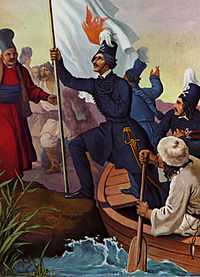Sacred Band (1821)

The Sacred Band (Greek: Ἱερὸς Λόχος) was a battalion founded by Alexander Ypsilantis at the beginning of the Greek War of Independence, in February 1821 in Wallachia, now part of Romania.
Origin and structure
It was named after the Sacred Band of Thebes, and composed of young Greek volunteers who rallied to Ypsilantis' call for revolutionary struggle. It was the first organized military unit of the revolution, with troops bearing a common outfit and equipment, plus a fair level of military discipline. The volunteers were mostly students coming from the Greek populations of the Black Sea, and the first core of the battalion had 500 people (later reaching up to 2,000). G. Kantakouzinos was the first commander of the Sacred Band, with Athanasios Tsakalov (one of the founders of the Filiki Eteria) as the second in command.
Battles fought
The unit participated in various battles fought against the Ottoman forces in the Wallachia, notably:
Its largest engagement was the Battle of Drăgășani on June 19, 1821, where it was destroyed almost to a man.
Despite its failure, it did inspire the uprising in mainland Greece in March 1821, when the Greek Independence War began.
Flag

The flag of the battalion held the Greek inscription ΕΝ ΤΟΥΤΩ ΝΙΚΑ (In this sign, conquer), motto of the Roman emperor and founder of the Byzantine Empire Constantine the Great, who is also portrayed in the flag with his mother Helena of Constantinople in the fashion of Greek Orthodox iconography.
On the inverse of the flag, it featured the inscription ΕΚ ΤΗΣ ΚΟΝΕΩΣ ΜΟΥ ΑΝΑΓΕΝΝΩΜΑΙ (From my ashes I am reborn) accompanied by an image of a Phoenix, the mythical bird that dies in flames and is reborn from its ashes.
The three colors of the flag respectively symbolized:
- Red for Patriotism
- White for Brotherhood
- Black for Sacrifice
External links
- Mount Holyoke College, Massachusetts - Alexander Ypsilantis's Proclamation of Revolt, 24 February 1821
- Michigan State University - The Greek Revolution and the Greek State
- Ohio State University - Outbreak of the Greek Revolution
References
- Goldstein, Erik. Wars and Peace Treaties 1816-1991. Routledge, 1992.
- R. Clogg, The Movement for Greek Independence, Macmillan, 1976
- Miller, William. The Ottoman Empire and Its Successors, 1801-1927. Routledge, 1966.